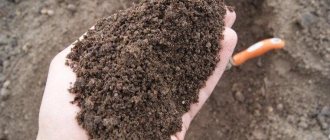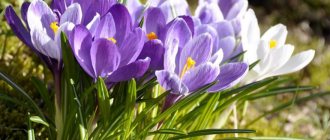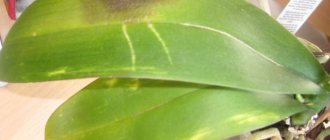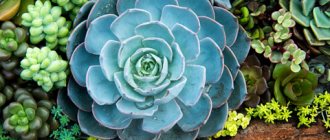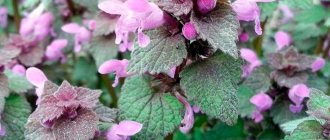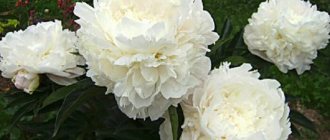Detailed description
This species is called the "black orchid".
In fact, in nature, phalaenopsis does not have a black color. The saturation, “thickness” of dark shades of burgundy, beetroot, and violet produces the effect of “blackness” in the colors of Kaoda and its hybrid descendants. The petals are not translucent, but dense, harsh, as if covered with varnish. The stem height reaches an average of 20 cm, the stem is completely hidden by leaves. The leaves are dark green, oval-shaped, glossy, grow up to 22–25 cm in length. 8–10 cm in width. They may be smaller, depending on the age of the orchid.
The peduncle appears from the leaf axil, can branch, and grows vertically. Kaoda usually has two branched peduncles . As a rule, it bears up to 8 – 12, sometimes more simultaneously open flowers. Flowers usually grow up to 4.5 cm in diameter. They may be slightly larger, depending on the clone, because within this variety there are 3 - 4 clonal varieties.
The flowers themselves are of regular shape with rounded petals, dense, textured, as if with leather embossing of a deep burgundy, sometimes beetroot color. The edges of the petals may have a thin white border. The lip is snow-white; there may be small burgundy specks on its surface. The lip is forked at the end.
ATTENTION : This variety does not have a dormant period as such. The orchid is ready to bloom all year round, but new flower stalks appear in spring or summer.
Very fragrant. It is not known what this is connected with, but Kaoda gives a special aroma only at lunchtime .
Difference from other species
The epiphytic plant has about 39 species, which are characterized by:
- powerful, not very long stem;
- wide leaf blades that do not change color throughout their existence;
- aerial root system;
- tall peduncles with butterfly flowers.
The main difference between an orchid hybrid is the color of the petals. However, the flowers differ from other subspecies of orchids in their dense structure and glossy shine. And also the distribution area.
Subvarieties: description and photo
There is one variety of Kaoda orchid . Below we provide its description and photo.
Kaoda "Chocolate Drobs Twinkle"
The variety is translated as “flickering drops of chocolate”, a medium-sized monopodial epiphyte. A very fragrant flower, simply mesmerizing with the combination of brightness of smell and color. The flowers are quite large, rich, dark purple, up to 5–7 cm. The stem grows up to 15–20 cm, it is covered with leaves. The leaves are strong, elastic, somewhat reminiscent of the leaves of Mini Mark - green, growing up to 15 cm in length. They may be smaller, depending on age. Unfortunately, this particular hybrid has no aroma.
Bloom
As you know, Kaoda does not have a specific dormant period; it can bloom all year round. The growth of new shoots - flower stalks - begins in spring or summer.
During flowering, Kaodu is not fertilized . Otherwise, there is a risk of dropping buds and accelerating flowering.
After it has faded, you can arrange a short “break” for the orchid lasting 2 - 3 weeks, this will be enough. At this time, watering is reduced and fertilizers may not be applied.
What to do if it doesn't bloom?
Kaoda orchid prefers warm temperatures . The most optimal temperature for growth and flowering is 24–32°C in summer, 16–22°C in winter.
IMPORTANT : To stimulate flowering, an orchid needs a temperature difference of at least 4 - 6 °C, plus a short period of rest in winter.
Features of flowering
The Kaoda orchid can rightfully be considered unique. This is due to the fact that the appearance of buds does not depend on the time of year; they can appear at any time. It is also worth noting that the flowering period is quite long. Quite often, the spring period begins for gardeners with the appearance of buds and flower stalks on the orchids being grown.
During the active growth of buds, it is not recommended to apply fertilizers and fertilizing, as this can negatively affect the culture and the orchid will drop its buds.
Care instructions
Selecting a location
Phalaenopsis Kaoda is best placed on windowsills on the western and eastern sides to avoid direct sun, this is dangerous for the orchid. It is desirable that the lighting does not deprive this special flower of soft, warm shades, leaving only dark silhouettes - spots, because Kaoda petals are dense, not transparent, they will simply fade in unfavorable lighting.
Preparing the soil and pot
Pot. It is recommended to grow this plant in pots or wooden slatted baskets. The diameter of the pot is usually average, up to 12 cm.- Substrate:
- The base is medium-sized pine bark or coconut chips.
- You can put sphagnum moss on the surface of the substrate to dry out the roots.
- Moss serves as an indicator for watering time. When it has dried to a “crunch”, after 1 - 2 days the orchid needs to be watered.
- Good drainage is required for air circulation to prevent the roots from rotting.
- Sometimes peat is added to keep the substrate from becoming saline.
Temperature
Kaoda orchid loves warmth and soft light; moderate temperature conditions are desirable. The most optimal temperature in hot summer is 24 – 32°C, in winter the permissible temperature range is 16 – 22°C.
Humidity
In terms of air humidity, this phalaenopsis is quite patient and flexible, but humidity below 40 - 45% is undesirable. In summer we increase the humidity; regular spraying of the flower is recommended . In this case, you should avoid getting water on the flowers and buds.
TIP : You can humidify the air by pouring water into additional containers and placing them near the pots.
Lighting
Lighting is standard, as for all phalaenopsis, partial shade, without access to direct sunlight. Blooms well and grows in completely uniform artificial light. In spring and summer. Bright diffused light.
The orchid does not tolerate direct bright sun . Do not expose the leaves to the risk of burns; monitor the lighting.
Watering
Watering directly depends on how the orchid is kept and the season. When planting Kaoda on a block, you need to water it every day, especially on hot summer days. If the orchid grows in a pot or basket, it needs to be watered once every 5 to 7 days. This variety is very resistant to drying and can remain unwatered for a long time.
During watering, carefully protect the rosettes and leaf axils so that water does not get there. Stagnation of water in these places can lead to rotting and further death. Immediately after watering, you can place the orchid under a fan, then all excess moisture will evaporate and will not cause harm.
- In spring and hot summer . Once a week, spill the soil with warm water on top of the pot, preventing water from accumulating. Soaking in water is not recommended. It is best to water in the morning. It is necessary to water only when all the roots have become a uniform silver-gray color.
- Autumn and winter . More rare and careful watering, approximately once every 10-14 days.
Watch a video about proper watering of an orchid:
Top dressing
- Fertilizer is usually combined with watering to ensure even distribution of nutrients.
- Fertilizing is applied every 2 - 3 weeks during active growth of leaves and roots.
- It is better to use organic fertilizers.
- Flowering plants are not fertilized so that the buds do not fall off, and the orchid blooms longer.
- Once a month we feed with fertilizers for orchids, strictly following the instructions.
Watch a video about proper feeding of an orchid:
Transfer
We replant the orchid when the substrate begins to decompose . If you planted an orchid in the bark, the “shelf life” of the soil usually expires after 2-3 years. Transplantation is desirable when the plant “sits” very tightly in the pot, it is cramped, the pot is “overflowing” with roots on all sides.
Watch a video about proper orchid transplantation:
Phalaenopsis Kaoda history of origin
The orchid culture owes its name to a student of the ancient Greek philosopher Plato. The scientist and naturalist Theophrastus discovered in the mountains an unusual plant with two bulbous roots. As a result, he named the discovered culture Orchis, which translated from ancient Greek means “little eggs.”
Several legends are associated with the appearance of phalaenopsis. So, according to one legend, a flower was born from pieces of a rainbow scattered on the ground. Another story says that phalaenopsis began to grow in the place where the ancient Greek goddess of love lost her sandals.
The plant was first mentioned 2000 BC in China. The first orchid was discovered by a German naturalist on one of the Moluccas islands. The genus gets its name from two Greek words: phalaina and opsis, which literally translate as “flower-like moth.”
In the mid-eighteenth century, a naturalist pastor from Sweden found another orchid, sending it to the naturalist Carl Linnaeus for study. Two years later, the scientist described the plant in his scientific work as Epidendrum the Beautiful, which is translated from ancient Greek as “dweller of trees.”
A century later, Dutch botanist and mycologist Carl Ludwig Blume found another wild phalaenopsis in the Philippine Islands. Looking at the forest at night with binoculars, he mistook the plant for a large white cutworm. In memory of his “mistake,” he named the plant Phalaenopsis (butterfly-like). Thanks to the efforts of breeders, the found orchid varieties became the parents of the phalaenopsis hybrid Kaoda Twinkle.
Important!
Kaoda’s “parents” were Phalaenopsis Schiller and Malva Rose Valentain Pearl, beloved by flower growers.
You may be interested in:
How to properly prune an orchid after flowering: basic pruning rules Orchids such as phalaenopsis bloom twice a year. The period lasts about two weeks, and another type of it...Read more...
How to propagate?
At home, the Kaoda orchid reproduces, like many phalaenopsis, with the help of lateral processes - “babies” on stems or on peduncles. It is important to maintain a temperature of 25°C and humidity of 60%. The process of separating the “babies”:
- We choose an adult, healthy orchid with good roots and large large leaves.
- Important - propagation must take place after flowering.
- In this case, the peduncle must still be fresh.
- Using a sharp knife, cut the top of the peduncle to the top “dormant” bud, and sprinkle the wound with charcoal.
- We transplant the new shoot into a previously prepared small greenhouse with a substrate - sphagnum (you can use an aquarium).
- We stop watering for several days.
Watch a video about orchid propagation by children:
History, origin and place of residence
Kaoda orchid (lat. Kaoda) is a full-fledged achievement of hybridization by current breeders. The beauty was born just a few decades ago. The young and still small genus includes epiphytes and lithophytes that prefer tree trunks or gorge stones as a base. New subspecies appear almost every year.
This is interesting: in the wild there is no phalaenopsis with this color.
Diseases and pests
Spider mites are a real misfortune for our phalaenopsis . A hot shower and spraying with various acaricides will help here; fitoverm is the most harmless. 3 – 4 treatments are required at weekly intervals.- Suppurations form in the axils of the leaves, in the roots and on the peduncle if the flower is overcooled and receives a lot of liquid. Immediately replant the orchid, change the substrate to fresh one, and reduce watering. Move the pot to a brighter, warmer place. If you find root rot, cut out all the rotten roots with a knife. It is recommended to sprinkle with cinnamon and grease with foundation.
To protect the orchid from pests and diseases, it is better to place the pots on grids so that the infection is not transmitted when watering. It is important to disinfect pots and tools when planting and propagating. Copper sulfate is usually used for disinfection.
Prevention of various problems
How to prevent orchid diseases:
- The leaves have become yellowish and have lost their bright, rich green color - reduce watering, adjust air humidity, and shade the windows.
- If the leaves begin to fall, then the humidity is insufficient, you have dried out the air. And perhaps the substrate also does not receive enough moisture. Spraying and additional watering are required.
- Leaves rot is a sign of improper care. Make sure that the leaves, sinuses, and rosette do not get wet, and if they get wet, they should be carefully wiped with a dry cloth or dried with a hairdryer.
Orchids amaze with their diversity; we suggest reading about the following popular varieties: Sogo, Brassia, Zygopetalum, Big Lip, Manhattan, Philadelphia, Beauty, Vanda, Cattleya, Liodoro.



